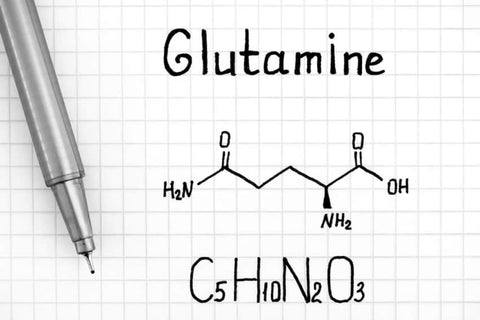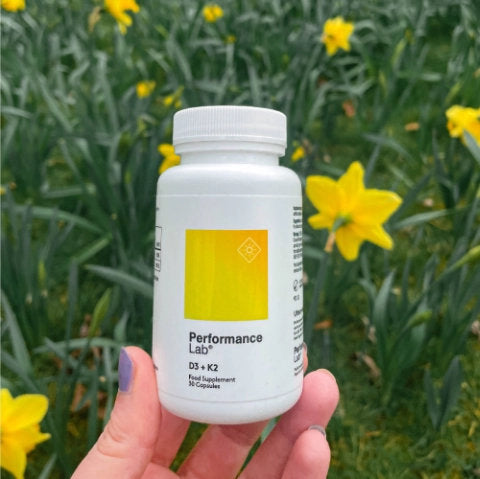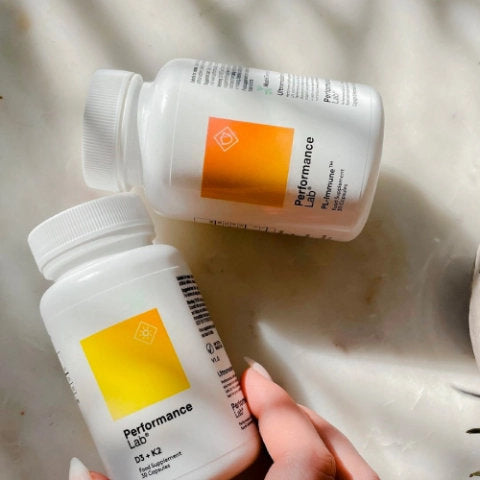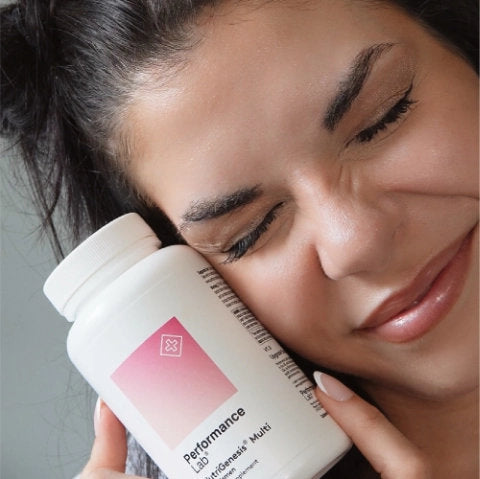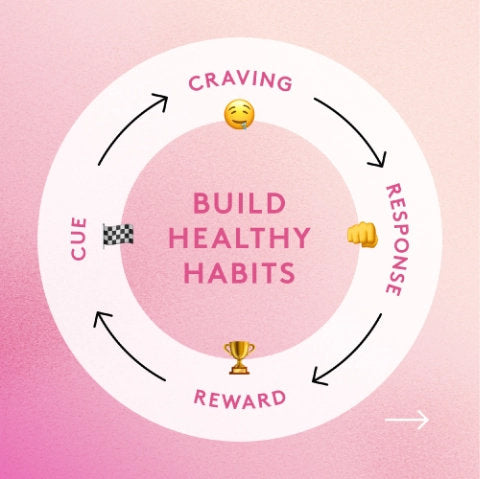Compared to things like pre-workout, BCAAs, protein, and creatine, glutamine isn't something you hear much about. Intestinal health? Maybe.
But if you're looking for muscle growth or strength gains, it typically isn't on the radar. Despite being added to many supplements and being widely available in health food stores, it seems to stay relatively low-key.
But it's time that glutamine gets its moment because it just might be more important than we give it credit for when it comes to exercise.
If you've never looked into glutamine, we're going to give you an overview of what you need to know about it and whether it's earned a place as a key ingredient in pre-workout supplements.
What Is Glutamine?
L-glutamine is a non-essential amino acid that is produced in the body and is also part of many food sources. It just so happens that glutamine is actually the most abundant amino acid in plasma and is actively transported in metabolized in nearly every tissue in the human body 1.
And although the body normally has large glutamine reserves and can synthesize glutamine endogenously, catabolic states such as intense exercise are characterized by a rate of glutamine consumption exceeding that of maximal glutamine production 1.
If the catabolic stress persists, glutamine deficiency may develop, hence why it's actually considered a "conditionally essential" amino acid—it becomes essential under certain circumstances.
Glutamine exists in two forms in the body: L-glutamine and D-glutamine. The L represents levo, or left, while the D represents dextro, or right.
They are basically mirror images of each other, and although each form of glutamine exists in specific ratios within the body, L-glutamine is the one that is of most use.
Approximately 70% of your body's internal glutamine is produced in skeletal muscle and is shuttled throughout the body.
Functions Of Glutamine
Despite being abundant in blood and tissues, glutamine is consumed rather rapidly, and this high turnover rate is due to the wide array of functions that depend on glutamine supply.
Although glutamine's function varies between tissues and physiologic states, its functions generally fall within four categories, the first three of which we will talk about:
- Nitrogen transport
- Maintaining the cellular redox state
- An energy source
- A metabolic intermediate

Image Credit: BI Labow, WW Souba. Glutamine. World J Surg. 2000;24(12):1503-1513. 1
Nitrogen Transport
Roughly a third of all nitrogen derived from protein metabolism is transported in the blood as glutamine 2, and a large portion of nitrogen supplied by skeletal muscle in the postprandial period is exported as glutamine 3.
It is what researchers call the "nitrogen shuttle", and it provides a nontoxic method of transporting ammonia to its target organ for regeneration or excretion.
Basically, glutamine picks up ammonia and shuttles it between tissues, where it can be used for a number of functions, one of which includes cell growth and tissue repair.
Additionally, the use of glutamine as a nitrogen shuttle is also critical to the removal of nitrogenous wastes and maintaining proper pH balance within the body.
The kidneys are a primary consumer of glutamine; the ammonia cleaved from glutamine is used to maintain acid-base homeostasis. As the body's acidity increases—in response to things like high-intensity training or increased protein intake—renal uptake of glutamine drastically increases.
But because there are so many uses of glutamine, deficiency can be quick to come by if it's not adequately generated or replaced.
Cell Redox Control
There's also a substantial amount of evidence suggesting that glutamine plays a significant role in regulating glutathione levels, your body's main antioxidant.
Glutathione is a tripeptide synthesized from the amino acids glutamate, cysteine, and glycine; it represents the major source of cellular reducing equivalents, which function to protect cells against oxidative damage 4.
And although there are a couple of ways by which glutamine can contribute to glutathione synthesis, the science behind it isn't totally necessary to understand right now.
What you do need to know is the role of glutathione in exercise physiology.
While it's suggested that glutathione is involved in the regulation of several physiological functions, its role in antioxidation and detoxification is of particular importance here.
Physical exercise decreases the reduced form of glutathione and increases the oxidized form; glutathione is easily oxidized by free radicals that are produced as by-products of intense exercise 5, and the balance between the oxidized and reduced forms indicates antioxidant status—high status equates to more cellular protection.
As well, prolonged exercise decreases total plasma and tissue glutathione content over time, suggesting that glutathione may be associated with aerobic energy metabolism and maintenance of muscle contraction.
Recent studies indicate that exogenous glutathione supplementation may contribute to aerobic metabolism during exercise.
While the mechanism behind how this happens is rather complicated, researchers have found that glutathione supplementation decreases plasma fatty acids and suppresses pH changes within muscles (reduces acidity).
Ultimately, this improves aerobic metabolism and mitigates the acidic environment in skeletal muscle during exercise by elevating PGC-1α to prevent exercise-induced fatigue 5.
Energy Production
The third function we want to focus on is glutamine as an energy source. Research shows that glutamine oxidation can also aid in the generation of ATP for cellular respiration, and in certain cells like enterocytes and lymphocytes, glutamine actually serves as the primary respiratory fuel 1.
While the total amount of energy derived from glutamine depends on the extent of oxidation and the rate of glutamine utilization, glutamine oxidation can account for up to one-third of ATP production in many cells under certain physiologic conditions.
However, it appears to have an inverse relationship with glucose; glutamine oxidation increases as glucose levels decrease 6, 7.
Basically, the less glucose you have, the more glutamine that's oxidized for fuel to support your workouts.
Glutamine and Pre-Workouts
Despite the number of roles glutamine plays in the body, there isn't a lot of evidence suggesting it's going to increase muscle mass, decrease body fat, or help you out in the strength or power department.
However, given that training is hard on the body and produces relatively high levels of free radicals, you may see certain benefits with supplementing glutamine in terms of cell damage and recovery; there could be further benefit if stacked with other ingredients.
Take citrulline, for example. Glutamine functions as an important precursor for the synthesis of arginine and plays a role in nitric oxide production via citrulline transport; it functions as a messenger substance to mediate nitric oxide production 8.
Higher NO levels help dilate blood vessels and increase oxygen delivery and nutrient transport to skeletal muscle, which may indirectly affect muscle growth and recovery.
Some studies suggest that glutamine supplementation may improve recovery by reducing muscle soreness and enhancing strength recovery 9.
One study found that L-glutamine supplementation helped preserve peak torque over a 96-hour period better than the placebo and attenuate muscle soreness.
But more than just for pre-workouts, the l-glutamine benefits for gut health are numerous, so it's a good idea to consider l-glutamine for your general health and wellbeing as well.
Final Thoughts
While it may not play a direct role in improving fitness outcomes, glutamine's most prominent role with respect to exercise may be via glutathione production to protect cells against free radicals produced during intense activity. So, including it in a pre-workout might not be such a bad idea.
And suppose you're looking to reap this benefit specifically. In that case, Pre Lab Pro® is formulated with Setria Performance blend that's been clinically shown to boost and sustain Nitric Oxide (NO) levels in the bloodstream 2x as long as L-Arginine or L-Citrulline alone.

Beyond working as a NO-boosting team in Setria® Performance Blend, Setria® Glutathione + L-Citrulline each supply their own distinct sports nutrition benefits:
Setria® Glutathione is a master antioxidant enzyme that also boosts levels of vitamins C and E to help:
- Protect muscle against cell-damaging oxidative stress during high-intensity training
- Strengthen immune function against challenges linked to exercise and gym pathogens
L-Citrulline raises L-Arginine to promote muscle growth and function via:
- Improving BCAA utilization, muscle energy, and anabolism while fighting against catabolism
- Supporting greater muscle power output while maintaining VO2 max (muscle efficiency)
- Helping to clear fatigue-inducing ammonia from muscle tissue
Performance Lab Pre is a powerful stim-free muscle primer designed to power you through all of your workouts.
It's intelligently stacked to boost and sustain nitric oxide (NO) levels for twice as long and nourish your muscles to protect against the build-up of lactic acid that can end sessions early.
What's not to love about that?
- BI Labow, WW Souba. Glutamine. World J Surg. 2000;24(12):1503-1513.
- WW Souba. Interorgan ammonia metabolism in health and disease: a surgeon's view. J.P.E.N. 1987; 11:569.
- M Elia, P Folmer, A Schlatmann, A Goren, S Austin . Amino acid metabolism in muscle and in the whole body of man before and after ingestion of a single mixed meal. Am. J. Clin. Nutr. 1989; 49:1203.
- A Meister, MA Anderson . Glutathione. Annu. Rev. Biochem. 1983; 52:711.
- W Aoi, Y Ogaya, M Takami, et al. Glutathione supplementation suppresses muscle fatigue induced by prolonged exercise via improved aerobic metabolism. J Int Soc Sports Nutr. 2015;12:7.
- P Wu, NG Ray, ML Shuler. A single-cell model for CHO cells. Ann. N.Y. Acad. Sci. 1992;665:152.
- A Krützfeldt, R Spahr, S Mertens, B Siegmund, HM Piper. Metabolism of exogenous substrates by coronary endothelial cells in culture. J Mol Cell Cardiol. 1990;22(12):1393-1404.
- J Bryk, JB Ochoa, MI Correia, V Munera-Seeley, PJ Popovic. Effect of citrulline and glutamine on nitric oxide production in RAW 264.7 cells in an arginine-depleted environment. JPEN J Parenter Enteral Nutr. 2008;32(4):377-383.
- B Street, C Byrne, R Eston. Glutamine Supplementation in Recovery From Eccentric Exercise Attenuates Strength Loss and Muscle Soreness . J Exerc Sci Fit. 2011 Dec;9(2):116-122.
